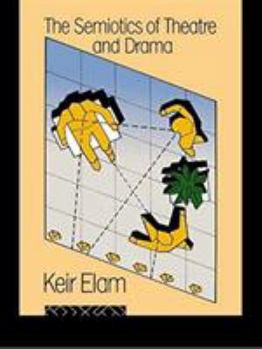The Semiotics of Theatre and Drama (New Accents)
Select Format
Select Condition 
Book Overview
The late twentieth century saw an explosion of interest in semiotics, the science of the signs and processes by which we communicate. In this study, the first of its kind in English, Keir Elam shows... This description may be from another edition of this product.
Format:Paperback
Language:English
ISBN:0415039843
ISBN13:9780415039840
Release Date:December 1990
Publisher:Routledge
Length:264 Pages
Weight:0.58 lbs.
Dimensions:8.0" x 5.3" x 0.8"
Customer Reviews
2 ratings
An essential book on the subject
Published by Thriftbooks.com User , 16 years ago
I believe about twenty percent of the theoretical writings on the arts in the past 40-50 years have said something significant and eighty percent have pretended to say something significant (usually hiding behind excessive use of slashes, parenteses, hyphens and very many obscure charts consisting of boxes and arrows). Semiology and structuralism were analytical approaches that could actually be used by practising artists (and were used by some) just like their firm use in linguistics and communications, but they got reduced to "rhetoric for rhetoric's sake" by post-Barthes speculative writers. Now I believe that these ideas are making a come-back because they are indeed applicable methodologies. If you are interested in learning about semiotical approaches to theatre and performance, especially if you are a practicing person "thinking" about your work, this book is a very good introduction and you may very well run into concepts you can find inspiring. It sums up the ideas, arguments and questions in a very readable, well-organized way. It may be a bit narrow in its approach to theatre (too heavy on "representational" theatre). I personally find the desperate desire to formularize a theatrical performance with tables and charts silly and Elam's last chapter is devoted to that but it can be taken as a documentation of a useless trend. First two chapters can serve as excellent guides into further information about the subject matter.
Too structuralistic to be entirely true
Published by Thriftbooks.com User , 19 years ago
We cannot reduce the approach of a play to the text and we have to take into account one particular production, but if there are dozens of different productions of one play, each one will be different including in the meaning. The book does not really differentiate the playwright's and director's roles. But the book does not integrate the tremendous revolution postmodernism represents against or in comparison with (according to the level of anatagonism in this confrontation) structuralism. The book is exclusively structuralistic and what's more of an older period. But it has not integrated the real position of playwright, or the director's, or even the actors', and absolutely not the audience's. Page 36, and again page 39, the author and director are reduced to a source, the audience to a destination. But a playwright and a director have each of them a complete psychological, historical, ideological, philosophical, referential, symbolical, etc, heritage, and this heritage is full of contradictions reflecting in a contradictory way the very contradictory vision these creators have of the contradictory reality that they see and try to recreate in their work. A play cannot be reduced to the text or even one particular production. These are the tips of two icebergs. Ben Jonson's Silent Woman being played by a man in those days was normal and this disguised woman being revealed later as a real man is of course absolutely essential for the audience of those days, but impossible to set on a modern stage. It would not work anymore. King Lear's clown being a man is standard, but to make him a woman like in the Theâtre du Jorat, Suisse's recent production changes an essential element in whose voice the clown is. If a man he can be anybody's voice. If a woman he can only be Cordelia's voice. The playwright and director try to build first a construct that is the text of the play and then another construct that is one particular production of this play. But the audience is not a simple receiver, nor a simple destination. The audience, both individually and collectively, has a complete psychological, historical, ideological, philosophical, referential, symbolical, etc, heritage that he/she/they project into the particular production of the play they are seeing or watching. They try to reconstruct the very construct of the playwright and the director and then they project their own heritage into this first level of construction and they move to a personal construct of what they think the the play they have seen of watched is about. Here we must consider the unconscious to go beyond the competence of the audience. They will react with their complete being and not only their educated selves. If we take these three essential personae into account the fundamental dimension missing in this book is the symbolical. We have to build today a symbolical semiotics centered both on the playwright/director and the audience. We must de-center semiotics from the play itself a






